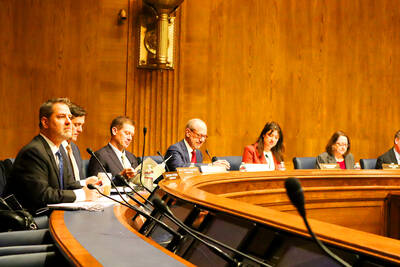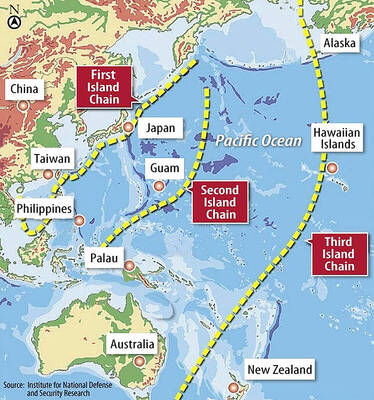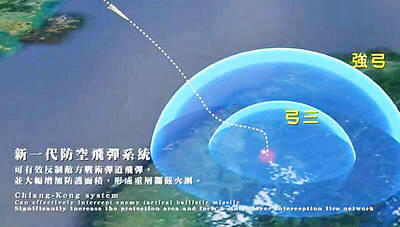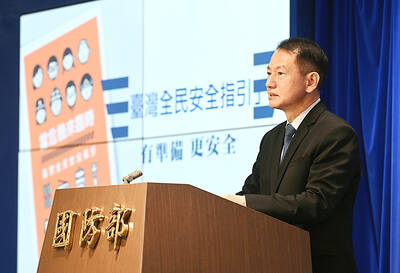Japan yesterday said that a Chinese military delegation was on a rare exchange visit as the Asian neighbors attempt to thaw frosty ties ahead of US president-elect Donald Trump’s inauguration on Monday next week.
Members of the Eastern Theater Command of the Chinese People’s Liberation Army were visiting their Japanese counterparts and senior Japanese defense officials from Monday through Friday, Japanese government spokesman Yoshimasa Hayashi said.
The trip was organized after the Japanese and Chinese defense ministers met in November last year in Laos on the sidelines of a regional defense gathering, where they agreed to increase exchanges among troops, Hayashi said.

Photo: Reuters
“For the first time in five years, this resumes exchanges among troops,” he told a regular news conference.
“The promotion of mutual understanding and trust through frank communication at commanders’ level will contribute to the building of constructive and stable relations between Japan and China. We think this visit contributes to the peace and stability of the region,” Hayashi said.
The Eastern Theater Command echoed the view.
“This visit will help enhance understanding and mutual trust between the two sides, and promote defense exchanges between China and Japan,” it said in a statement.
Japan and China have been trying to patch up relations that for years have been strained by territorial and historical disputes, as well as other issues.
To ease tensions, Japanese Minister of Foreign Affairs Takeshi Iwaya last month visited Chinese Minister of Foreign Affairs Wang Yi (王毅).
Japanese lawmakers were also visiting China this week, and Japanese Minister of Agriculture, Forestry and Fisheries Taku Eto is due in the country today.
Japanese National Security Adviser Takeo Akiba visited China in November last year and held talks with Wang. Tokyo is expected to invite Wang to Japan next month, seeking to pave the way for a state visit by Chinese President Xi Jinping (習近平), the Nikkei reported.

LIMITS: While China increases military pressure on Taiwan and expands its use of cognitive warfare, it is unwilling to target tech supply chains, the report said US and Taiwan military officials have warned that the Chinese People’s Liberation Army (PLA) could implement a blockade within “a matter of hours” and need only “minimal conversion time” prior to an attack on Taiwan, a report released on Tuesday by the US Senate’s China Economic and Security Review Commission said. “While there is no indication that China is planning an imminent attack, the United States and its allies and partners can no longer assume that a Taiwan contingency is a distant possibility for which they would have ample time to prepare,” it said. The commission made the comments in its annual

DETERMINATION: Beijing’s actions toward Tokyo have drawn international attention, but would likely bolster regional coordination and defense networks, the report said Japanese Prime Minister Sanae Takaichi’s administration is likely to prioritize security reforms and deterrence in the face of recent “hybrid” threats from China, the National Security Bureau (NSB) said. The bureau made the assessment in a written report to the Legislative Yuan ahead of an oral report and questions-and-answers session at the legislature’s Foreign Affairs and National Defense Committee tomorrow. The key points of Japan’s security reforms would be to reinforce security cooperation with the US, including enhancing defense deployment in the first island chain, pushing forward the integrated command and operations of the Japan Self-Defense Forces and US Forces Japan, as

INTERCEPTION: The 30km test ceiling shows that the CSIST is capable of producing missiles that could stop inbound missiles as they re-enter the atmosphere Recent missile tests by the Chungshan Institute of Science and Technology (CSIST) show that Taiwan’s missiles are capable of intercepting ballistic missiles as they re-enter the atmosphere and pose a significant deterrent to Chinese missile threats, former Hsiung Feng III missile development project chief engineer Chang Cheng (張誠) said yesterday. The military-affiliated institute has been conducting missile tests, believed to be related to Project Chiang Kung (強弓) at Pingtung County’s Jiupeng Military Base, with many tests deviating from past practices of setting restriction zones at “unlimited” and instead clearly stating a 30.48km range, Chang said. “Unlimited” restrictions zones for missile tests is

PUBLIC SAFETY: The nationwide distribution campaign aims to enhance society’s overall understanding of threats and bolster defense awareness, an official said The latest edition of the National Public Safety Guide is being mailed to all citizens starting today to foster public awareness of self-defense in the event of war or natural disasters, the Ministry of National Defense said yesterday. “The guides will be disseminated to the public to enhance society’s overall understanding of threats and bolster defense awareness, demonstrating the government’s emphasis on people’s safety and its determination to pursue self-defense,” All-out Defense Mobilization Agency Director Shen Wei-chih (沈威志) said at the ministry’s news conference. The nationwide distribution campaign was planned according to President Lai William’s (賴清德) Sept. 20 directive, he said, adding